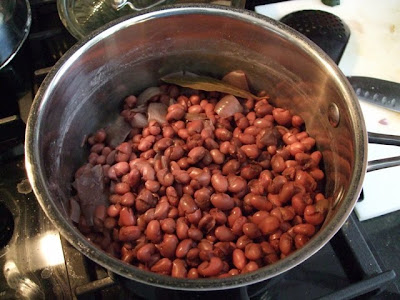On one of our first forays off the boat in the Bahamas I ordered Peas and Rice at Angela Starfish on Harbour Island.
They were so good I had to ask how to make them. Angela was a little vague, not because she didn't want to share a secret recipe but I think because she couldn't believe there was anyone on earth who didn't already know how to make them. Finally I wheedled out of her a few key ingredients: onions, peppers, thyme. It's a start.
Back at the boat I spent some time with my cookbooks and searched online for an authentic recipe for Bahamian Peas and Rice. No go. But I put the pigeon peas on to soak anyway Sunday night. Monday morning Bandit showed up to collect our mooring fee and I asked him about making peas and rice. He was pretty suspicious of the question at first but eventually I think he figured I was asking in earnest and began a long, explicit step by step explanation of the process. I wish I could convey his lovely lilting accent as he patiently talked me through the recipe.
He started the recipe with 2 strips of bacon, chopped up and fried, but said you could use oil instead and I did. Sauté chopped onions and green pepper (I only had red pepper) for a while. Add thyme. I didn't have any fresh thyme so I used about a little less than a teaspoon of dried.
"How about garlic?" I asked.
"It's whatever you like. However you like it."
I added garlic.
Then add about 1/2 cup of tomato sauce. Some recipes I saw said tomato paste but I asked Bandit and he said "regular tomato sauce," whatever that is. I used 1/2 cup of generic sauce from a jar that I happened to have in the fridge.
"And some Lea & Perrins, salt and pepper."
"Cook that for 20 minutes," my informant said.
"Really? Twenty minutes?" It seemed like a long time to me, but he gave me a knowing nod. In reality, I cooked it for about five minutes.
Add a cup of rice and stir and cook for a few more minutes before adding 2 cups of water. Bring to a boil, then add pigeon peas, either canned, drained, or home-cooked, as I did. I used the bean cooking water as part of the liquid for the rice.
Give it all another stir, cover and reduce the flame to low.
"And don't touch it again," said Bandit. "If you have to stir, use a fork and run that through."
I didn't touch it, even though I knew the burners on our propane-fired boat stove won't turn down low enough not to scorch the bottom of almost anything I cook. On the other hand, some recipes I read said this crusty bottom is key the the dish.
When the rice was cooked I turned off the burner and let the pot sit for a few minutes with the lid on. I like to think that helps loosen the stuck bottom but I'm not sure it really works. In the end I scraped the bits out and mixed it all up.
Add hot sauce if you must, but this dish was delicious as is.
The next day I thanked Bandit and told him his directions were perfect!





























